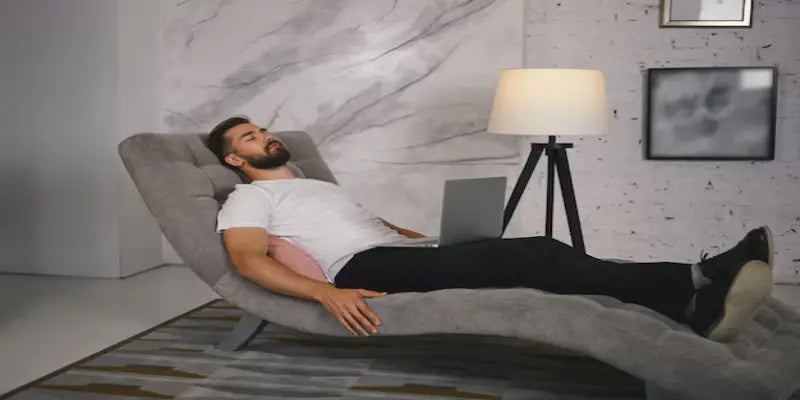
Get Rid of Neck Pain by Using a Cervical Pillow
India has seen a rise in lifestyle-related neck pain in recent years. With more people working from home or sitting for extended periods in front of computers or mobile phones, poor posture has become a leading cause of neck pain.
According to recent studies, nearly 20% of the Indian population experiences some form of neck pain at some point in their lives. This pain can range from mild discomfort to severe, debilitating conditions, often caused by poor posture, prolonged sitting, or sleeping in an awkward position.
One of the most effective and comfortable ways to alleviate neck pain is by using a cervical pillow. In this blog, we’ll explore how a cervical pillow helps in neck pain and how you can choose a cervical pillow for yourself, along with tips to prevent neck pain.
What is a Cervical Pillow?
A cervical pillow is specially designed to support the natural curve of your neck. Unlike standard pillows that can cause your head to be propped up too high or too low, cervical pillows are contoured to fit the shape of your neck and upper spine. This alignment helps maintain the proper posture while you sleep, preventing the muscles and ligaments of your neck from straining overnight.
There are different types of cervical pillows available in the market. Most cervical pillows are made from memory foam or other materials that mold to the shape of your neck and head, providing tailored support where it’s needed most. Whether you sleep on your back or side, the pillow’s design ensures your neck stays aligned with your spine, reducing the risk of pain upon waking up.
How Cervical Pillows Help Relieve Neck Pain
Cervical pillow can help in getting relief from neck pain and to manage the pain in long term, here is how:
Promotes Proper Spine Alignment
One of the main benefits of using a cervical pillow is that it helps with proper spinal alignment. It supports the natural curve of your neck and helps to keep your spine in a neutral position while you sleep. This reduces pressure on the cervical spine, minimizing the chances of waking up with stiffness or pain.
Reduces Strain on Muscles and Ligaments
When your neck is not properly supported, the muscles and ligaments in the neck area have to work overtime to keep your head in place. Over time, this can lead to muscle strain and pain. A cervical pillow helps to ease this strain, allowing your muscles to relax fully during sleep.
Relieves Pressure Points
Cervical pillows are designed to distribute weight evenly across the neck and shoulders, which helps reduce pressure points. This is particularly helpful for those who suffer from chronic neck pain caused by muscle tension, herniated discs, or other conditions.
Encourages Better Sleep Quality
Those who suffer from neck pain know how badly it affects their sleep quality, the discomfort that keeps you tossing and turning throughout the night. Using a cervical pillow can significantly improve your sleep by providing consistent support and comfort, allowing you to rest deeply and wake up fresh in the morning.
How to Choose the Right Cervical Pillow for You
When it comes to selecting a cervical pillow, there’s no one-size-fits-all solution. Different individuals have varying neck pain issues, so it's important to find a pillow that works for your specific needs.
Here are a few things to consider:
Sleeping Position
The position you sleep in is an important factor to consider while choosing the perfect cervical pillow for yourself. If you are a back sleeper, choose a pillow with a gentle curve that supports the natural arch of your neck. If you are a side sleeper, look for a pillow with a higher profile to fill the space between your neck and the mattress. If you are a stomach sleeper, there is nothing that can help you, avoid sleeping on your stomach at any cost.
Material
Memory foam is one of the most popular materials for cervical pillows due to its ability to contour to the shape of your head and neck. Because of its viscoelasticity, memory foam molds when heat or pressure is applied on it. So when you lay down your head on the pillow, it is able to provide good support to your neck. However, latex or buckwheat pillows are also great options for those who prefer a firmer or more natural feel.
Firmness
It’s important to select a pillow that is firm enough to provide adequate support but not so hard that it causes discomfort. Some cervical pillows offer adjustable firmness, which is ideal if you like to fine-tune the feel to your preference.
Size
Cervical pillows come in various sizes. Make sure the pillow you choose fits your body size and sleeping habits. A pillow that’s too small or too large may not provide the necessary support.
Tips for Preventing Neck Pain
Using a cervical pillow is just one part of the solution for managing neck pain.
Here are some additional tips to help prevent and reduce neck discomfort:
- Maintain Good Posture: Ensure that your head and neck are aligned properly with your spine, both when sitting and standing.
- Take Frequent Breaks: If you have a desk job, make sure to take breaks every hour to stretch and move around.
- Stay Active: Regular exercise, especially neck and shoulder stretches, can help keep your muscles strong and flexible, reducing the likelihood of pain.
- Use Ergonomic Chair: If you spend long hours at a desk, invest in an ergonomic chair and workstation setup that supports your neck and back properly.
Conclusion
Neck pain can affect your quality of life but with the right cervical pillow and lifestyle changes, you can find relief. Using a cervical pillow can help you sleep better at night and help you wake up feeling refreshed and pain-free in the morning. It supports your neck’s natural curve and encourages proper alignment. Consider your best sleeping position, the material and size of the cervical pillow before investing in the cervical pillow for yourself. Along with using a cervical pillow, follow the tips above to prevent neck pain in the long run.
FAQs
Q. Do Cervical Pillows Really Work?
Ans. Yes, if your neck pain is caused by incorrect posture or muscle injury. In other instances, they provide relief from neck pain.
Q. How Long Do Cervical Pillows Last?
Ans. That depends entirely on the material for the fill. A memory foam pillow can last you more than 5 years because of the durable nature of the material.
Q. Should I Use a Cervical Pillow After My Neck Pain is Gone?
Ans. If you find it better than a normal pillow, then yes. However, we recommend that you go for a memory foam pillow, as it helps in maintaining good alignment and provides better support to your neck.
Q. When Should I Go to the Doctor to Get My Neck Pain Checked?
Ans. If the pain is chronic or there are red flag signs mentioned in this article, then you should go to a doctor as soon as possible.








